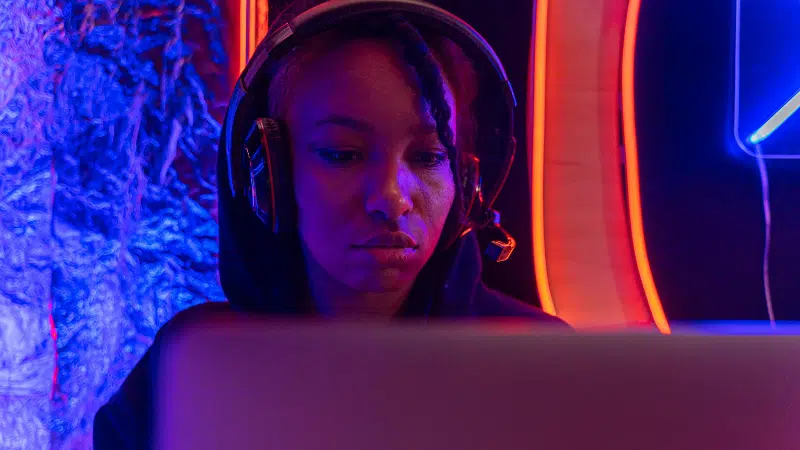Going viral may be exciting in the moment, but it no longer guarantees life-changing success for artists. Getting your music heard by the masses, but also true success as an artist, requires playing the long game. And part of that game is understanding how discovery works. Editorial playlists are great if you can get them, but they’re not the only way (or even the most reliable way, for that matter) to grow your audience. What really moves the needle over time is the algorithm, those behind-the-scenes tools that recommend your music to people who’ve never heard of you… yet.
Although you can’t control everything, you can absolutely influence a lot. In this article, we’ll break down how to work with the DSP tools you already have in your arsenal to boost your visibility and grow your audience in no time…
How to Influence Algorithms & Leverage DSP Tools to Grow Your Audience
Editorial vs. Algorithmic Playlists
When it comes to getting your music heard on streaming platforms, not all playlists are created equal. Some are handpicked by real people while others are driven by data and behavior. Knowing the difference helps you understand where to focus your energy.
- Editorial playlists are curated by the platform’s in-house team, like Spotify’s RapCaviar, Fresh Finds, or New Music Friday. Getting placed here is a huge win, but it’s competitive and not something you can control.
- Algorithmic playlists, on the other hand, are generated automatically based on what listeners like, save, and engage with. These include things like Release Radar, Discover Weekly, Spotify Radio, and Daily Mixes. The more listeners interact with your music, the more the algorithm pushes it to similar listeners.
On one hand, editorial playlists can give you a sudden boost in streams, some visibility, and even more followers. But once you’re off that playlist, that momentum can fade just as fast as it came if there’s no ongoing strategy behind it.
Algorithmic growth, on the other hand, builds over time. It’s based on listener behavior, so if people are saving your music, finishing songs, and coming back for more, platforms will keep recommending you to new audiences. Yes, it’s a slower burn, but a more sustainable path. Especially if you’re releasing consistently and making it easy for fans to engage with your music through methods like encouraging saves, shares, follows, and playlist adds through clear calls-to-action and easy access across platforms.
How To Improve Algorithmic Visibility
Sorry to break it to you, but you can’t get the algorithm to notice your music through shortcuts or life hacks… but you can give it the right signals. Some proven ways to boost your chances include things like:
- Releasing music consistently: The more often you put out quality music, the more chances the algorithm has to recommend you.
- Focusing on save rate: When fans save your songs to their libraries or playlists, it tells the algorithm your music is worth keeping around.
- Driving pre-saves and follows: Pre-saves show there’s anticipation before your music drops, and followers mean more people get your releases in their Release Radar, both strong signals to the algorithm.
- Engagement beats vanity metrics: Streams matter, but saves, shares, playlist adds, and full listens show deeper interest, which the algorithm rewards. (Think about building a connection, not just chasing numbers.)
- Finish rates are key: The algorithm favors tracks people listen to all the way through. So keep your music dynamic and engaging from start to finish.
Remember, it’s about quality and consistency, building habits that keep listeners coming back and, in turn, the algorithm pushing your music to more people. But what exactly can you do to make these happen?
- For example, releasing music consistently keeps you fresh in listeners’ minds, so you could consider scheduling new singles or EPs every few weeks or months to build steady momentum.
- To encourage saves, try directly asking your fans on social media to save your track if they like it, or create fun challenges where saving the song is part of the goal.
Pre-save campaigns are another powerful tool. With services like Feature.fm, un:hurd, or Toneden, you can easily get fans to pre-save your upcoming releases, which signals anticipation to streaming platforms. Don’t forget to remind your audience to follow you on Spotify so your new songs land in their Release Radar playlists.
- To encourage deeper engagement, you can prompt fans to share your music on their social channels or add it to their personal playlists, since shares and playlist adds carry more weight with the algorithm than simple streams.
- And to boost finish rates, make sure your songs grab attention early on, keep listeners hooked throughout, and avoid long pauses or filler sections. You can even ask fans to share their favorite part of the song to promote full listens.
All of these are practical steps that will help you send strong signals to the algorithm to recommend your music to new listeners. ⚡️
Want to go deeper on how Spotify’s algorithm works? Check out “How To Feed The Spotify Algorithm To Get More Streams” to learn more tips and tricks to help you hack the algorithm.
——
🪩 Get a lil extra with these helpful resources…
How To Leverage Physical Distro Sales To Grow Your Fanbase
Mental Health Resources for Musicians in 2025
Your Story Starts Here: A Chapter of FEATURETTE
10 Music Industry Job Sites To Help You Land Your Next Job
——
Spotify’s Pitch Tool
If you’re releasing music on Spotify, the pitch tool inside Spotify for Artists is one of the most important (and underused) tools at your disposal. It’s a free feature that lets you submit an unreleased track directly to Spotify’s editorial team for playlist consideration… but it also does a hell of a lot more than that.
When you use the pitch tool, you’re helping Spotify’s system understand your music. The info you provide, like genre, mood, instrumentation, language, and culture, feeds into both human curation and Spotify’s algorithmic recommendations. That’s why even if you don’t land on an editorial playlist, using the pitch tool still helps your track get in front of the right listeners through algorithmic playlists like Release Radar and Discover Weekly.
The written pitch is your chance to add context. Keep it short but specific. Mention the story behind the track, any collaborators, who the song is for, or how it ties into a cultural moment. The more relevant info you give, the more likely Spotify is to find the right audience for it.
📝 NOTE: You’ll need to submit your pitch at least 7 days before release, and it must be unreleased. In addition, you can only pitch one song per release, so make sure to choose your strongest track or the one you think will resonate most.
Using the pitch tool doesn’t guarantee a placement per se, but it absolutely gives your music a better shot at being surfaced, both by editors and by Spotify’s recommendation engine. Once your song is out, Spotify watches how people interact with it. So the more engagement you generate early on, the better your chances of long-term traction.
The Power of YouTube
YouTube isn’t just a video platform… It’s the second-largest search engine in the world and a major player for music discovery. It offers one of the best ways to build a strong visual identity, tell your story, and turn casual listeners into loyal fans. Plus, content you post here sticks around a lot longer than a TikTok or Instagram Reel, making it one of the most evergreen platforms in the game.
Unlike the fast scroll of TikTok or Instagram, a well-optimized video on YouTube can keep bringing in new listeners for months or even years. To ensure you make the most of everything the platform has to offer, here’s what you can do:
- Upload more than just the music video. Try visualizers, lyric videos, acoustic versions, or behind-the-scenes content from the studio or shoot days.
- Use Shorts strategically. Tease your release, promote pre-saves, or share moments that highlight your personality. Pinned comments and links in your bio can direct viewers to Spotify or your Linktree.
- Make your channel look legit. Add clear branding (channel art + profile photo), write a strong “About” section, and organize videos into playlists by theme or release
- Think about SEO. Good titles, clickable thumbnails, and the right keywords in your description can help your videos show up in search results and suggested videos.
- Link everything. Add links to Spotify, your website, social pages, and merch in the video description and About section.
🪄 🎬 If you aren’t familiar with the magic of SEO on YouTube, check out “How To Help Your Music Videos Perform Better on YouTube with SEO” to learn how to get your YouTube videos to stand out and ensure they’re getting shown to as many fans as possible.
Connecting Platforms for Ongoing Growth
One of the most powerful ways to grow on DSPs like Spotify is by building momentum outside of them. TikTok and YouTube aren’t just social platforms; they’re discovery engines. And when they’re working together, they can create a loop that drives listeners back to your music over and over.
For example, if a TikTok clip using your song catches on, this typically leads people to search for it on Spotify. Then, a YouTube visualizer or behind-the-scenes video could keep fans engaged after they’ve streamed the track. Just remember that each platform plays a different role: TikTok for quick viral moments, YouTube for deeper storytelling, Spotify for full listening experiences.
- Stretching this content across platforms is easier than you think, too. You put a lot of time and effort into creating the perfect music video; don’t let that hard work go to waste! You can get the most out of your efforts by repurposing that video into brand-new content babies to share across platforms.
📚 Need help getting your creative juices flowing? Check out “8 Types of Repurposed Content You Can Create From Your Music Videos” to get the full rundown on how to do this with ease.
That said, the key here is to think of your content as connected, not isolated. Use your TikTok videos to point fans toward your Spotify. Drop a Spotify link in your YouTube description. Use Spotify Canvas visuals that feel consistent with the vibe of your short-form content. When fans encounter your music in multiple places, they’re more likely to follow, save, and share. This repeated exposure helps feed the algorithm, and the engagement you generate on one platform can fuel visibility on another.
It’s not about doing everything at once; it’s about creating a cycle that keeps people coming back.
To wrap things up…
One viral video isn’t going to give you a lasting career, lifelong fans, or streams that span your entire discography. But you know what will? A thought-out strategy, a plan to push your music across platforms, and the patience to play the long game. Focus on building real connections with your audience, releasing music consistently, and using every tool at your disposal. From Spotify’s pitch tool and SEO optimized YouTube videos to TikTok clips and more, keep your momentum growing any way you can with a professional strategy to back you up. Now, that’s how you turn a moment of buzz into a career that lasts.
Good luck!



